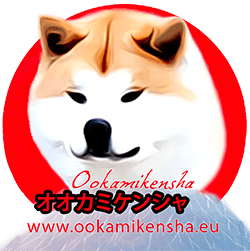Akita Inu
Brief historical summary
Originally, Japanese dogs were small to medium in size and no large breeds existed. Since 1603 in the Akita region, Akita Matagis (medium-sized bear-hunting dogs) were used as fighting dogs. From 1868 Akita Matagis were crossed with Tosas and Mastiffs. Consequently, the size of this breed increased but characteristics associated with the Spitz type were lost.
In 1908 dog fighting was prohibited, but this breed was nevertheless preserved and improved as a large Japanese breed. As a result, nine exceptional specimens of this breed were designated as «Natural Monuments » in 1931.
During World War II (1939-1945), it was common practice to use dogs as a source of fur for military garments. The police ordered the capture and confiscation of all dogs with the exception of German Shepherd Dogs, which were used for military purposes. Some dog enthusiasts tried to circumvent the order by crossbreeding their dogs with German Shepherd Dogs.
When World War II ended, Akitas had been drastically reduced in number and existed as three distinct types: 1) Matagi Akitas, 2) fighting Akitas, and 3) Shepherd Akitas. This created a very confusing situation in the breed.
After the war, during the restoration process of the pure breed, Kongo-go – a dog of the Dewa line – gained a brief but huge popularity. However, he exhibited characteristics of the Mastiff and German Shepherd, and dog experts did not approve of this type as a proper Japanese breed. They made efforts to eliminate external, foreign strains by crossbreeding with Matagi Akitas for the purpose of restoring the original pure breed. They succeeded in stabilizing the pure strain of the large sized breed we know today.
General appearance:
Large-sized and sturdily built dog, well balanced and with strongly marked secondary sexual characteristics.
Important proportion:
The ratio of height at withers to length of body ( from the point of the shoulders to the point of the buttock) is 10 : 11, but the body is slightly longer in female than in male.

Height at the withers:
Males: 67 cm
Females: 61 cm
There is a tolerance of
± 3cm more or less.

Head
Skull:
The size is in proportion to the body. The forehead is broad, with distinct furrow. No wrinkles.

Stop:
Nose:
Relatively long, strong and with a broad base, tapering but not pointed. Straight nasal bridge.
Muzzle:
Strong teeth with scissor bite

Lips:
tight
Cheeks:
moderately developed

Eyes:
Relatively small, almost triangular in shape due to the rising of the outer eye corner, set moderately apart, dark brown : the darker, the better.
Ears:
Relatively small, thick, triangular, slightly rounded at tips, set moderately apart, pricked and inclining forward.

Neck:
Thick and muscular, without dewlap, proportioned to the head.

Body
Back:
straight and strong

Loin:
broad and muscular
Chest:
Deep, forechest well developed, ribs moderately well sprung.

Belly:
well drawn up
Tail:
High, thick, carried vigorously curled over the back; the tip nearly reaches the hocks when let down
Limbs
Shoulders:
Moderately sloping and developed

Elbows:
tight

Forearms:
straight and heavy-boned

Hindquarters:
Well developed, strong and moderately angulated
Feet:
thick, round, arched and tight

Gait:
Smooth and powerful movement
Coat
Fur:
Outer coat harsh and straight, undercoat soft and dense ; the withers and the rump are covered with slightly longer hair ; the hair on tail is longer than on the rest of the body.
Color:
Red fawn, sesame (red fawn hairs with black tips), brindle and white. All the above mentioned colours except white must have « urajiro ». (Urajiro = whitish coat on the sides of the muzzle, on the cheeks, on the underside of jaw, neck, chest, body and tail and on the inside of the legs).
Faults
Any departure from the foregoing points should be considered a fault and the seriousness with which the fault should be regarded should be in exact proportion to its degree and its effect upon the health and welfare of the dog.
• Masculine females and effeminate males
• Pronounced over – or under – bite
• Missing teeth
• Blue or black spots on the tongue
• Bright eyes
• Short tail
• Shyness
Disqualifying faults
• Ears not pricked
• Hanging tail
• Shaggy, long hair
• Black mask
• Markings on white ground
© 2021 Ookami kensha, All Rights Reserved. Provided by Icostudio.tech
